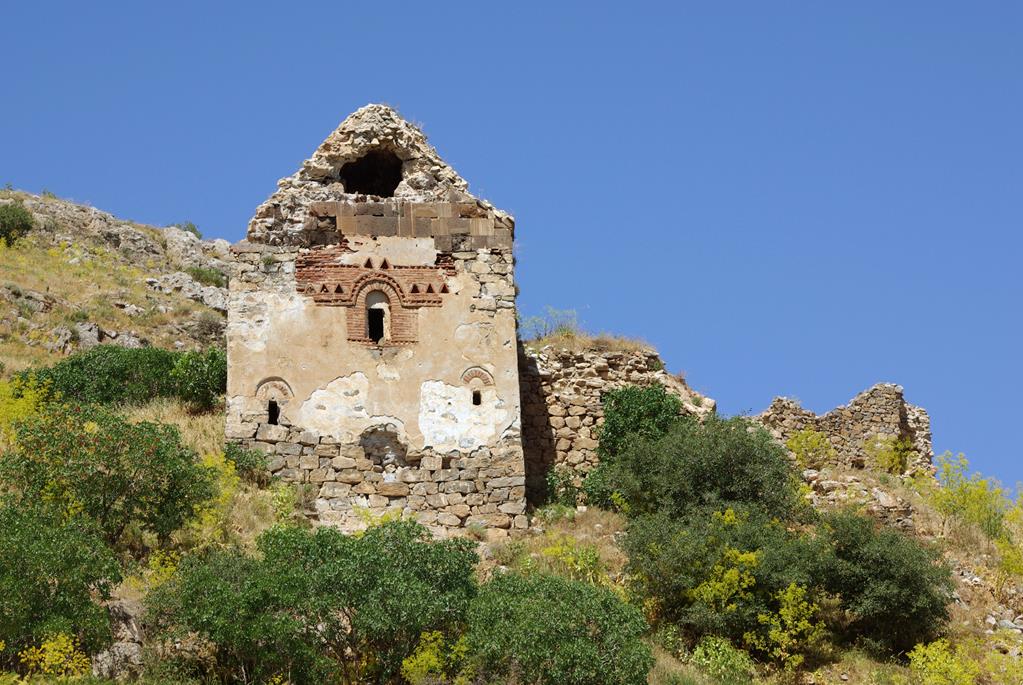The monastery of the Holy Resurrection is built on the south shore of Lake Van at 38° 29’ N and 42° 51’ E. It stands on the northernmost tip of the Gabudgogh [Akkül Dağı] Peninsula beyond the village of Aghin [Akkül Dağı] and the bay of Shakhor [Ahnatap], at the far end of a little gulf. It also goes by the name of a grotto located nearby to the west, Tivapuyn (of Divabuyn), “Devils’ Den”, a name that passed into Turkish as Deveboynu and designates this end of the peninsula.
It is highly likely that the Tivapuyn monastery is none other than the Andzëghnabad monastery mentioned in 13th-15th century texts as being in this region. The dedication – to the Holy Sign (Surp Nëchan) – may have been changed, probably after a period of abandonment. Whatever the case, the typological analysis of the church, whose ground plan is strikingly similar to that of the church of Piuragan (or Biurakan, in the Republic of Armenia), built in 905 by Catholicos John V of Traskhanaguerd (Hovhannes Traskhanaguerdtsi), authorizes attribution of its foundation to the same Catholicos, whose wanderings brought him to the Vasbouragan and to King Kakig (Gaguik) between 928 and 931. This hypothesis backdates the establishment of the monastery to the first half of the 10th century, when it was a “desert”, if its primitive name, Andzëghnabad, is to be read as Andzëghna Anabad, that is Andzëghn or Andzghën desert.

Vue générale, 2011 (Coll. P. Maguesyan).
In the cemetery, an inscribed date of 1272 marks the grave of the catholicos of Aght‘amar, Stephen II (Sdep‘anos). The catholicos of the Ardzrunid royal family established in Aght‘amar demonstrated their attachment to this spot. The church was restored in 1447 under the pontificate of Zacharia III the Great (Zak‘aria, 1434-1464): at that time it already carried the name of the Holy Resurrection. Zacharia’s nephew and successor, Stephen IV (1465-1489), appointed his own maternal uncle and tutor, the copyist and chronicler Thomas (T‘ovma) Minassents, abbot, while he crowned another of Zacharia’s nephews, his half-brother Sempad (1466, see n° 17), king at Aght‘amar. Catholicos Gregory III (Krikoris) would also inscribe his name there in 1589. In the following centuries, the monastery seems to have been above all a place of retreat and prayer. Plundered during the 1895 massacres, it was deserted a short time later and its running entrusted to a priest from Shadwan [Aydınocak].
The monastery of the Holy Resurrection includes:

Plan and section (Thierry, 1989, 310)
• The church of the Resurrection, a single-vessel nave with three apses, measuring 10.5 × 5.6 m and 9 m in height, a pointed barrel vault and a pitched roof; it has a central apse with a triumphal arch and a slightly rounded back with very narrow side chambers; the nave, which contained an ancient cross-stone, is lined with niches under arches set into the side walls. In the course of its restoration in 1447, the west façade of the church was adorned with an unusual brick pattern.
• A narthex 9.4 × 7.3 m set on posts and open to the north, a late construction.
• A chapel built later against the north wall of the church and opening on the north side into a room that may have been used as a library.
• Outbuildings situated northwest of the preceding set of buildings.
• Further to the west and halfway along the slope, the prior’s house.
• A cemetery.
• A well, near the shoreline.
The monastery also had a house outside the walls (trsi dun) in the village of Shadwan. The farmers of Varents [Varis] worked the land.
Confiscated after the Great War, the monastery of the Holy Resurrection was left empty. In the 1970s it was used as a sheepfold, but since then it has deteriorated considerably. The covering stones and all the stones framing the openings or decorating the upper parts of the east and west walls of the church have been removed together with their inscriptions. The vault is no longer protected and is partially open to the sky, while the foot of the south wall has been excavated in places. The cross-stone inside the church, has disappeared. The adjoining chapel has collapsed and its annex can no longer be seen. Only a few traces remain of the narthex and the monastic buildings. The grave of Catholicos Stephen (1272) has been destroyed.
Akinian, 1920, 40-41, 118, tabl. Oskian, 1940-1947, I, 141-143, 188-189. Adjarian, 1972, II, 334-336. Thierry, 1989, 308-314.